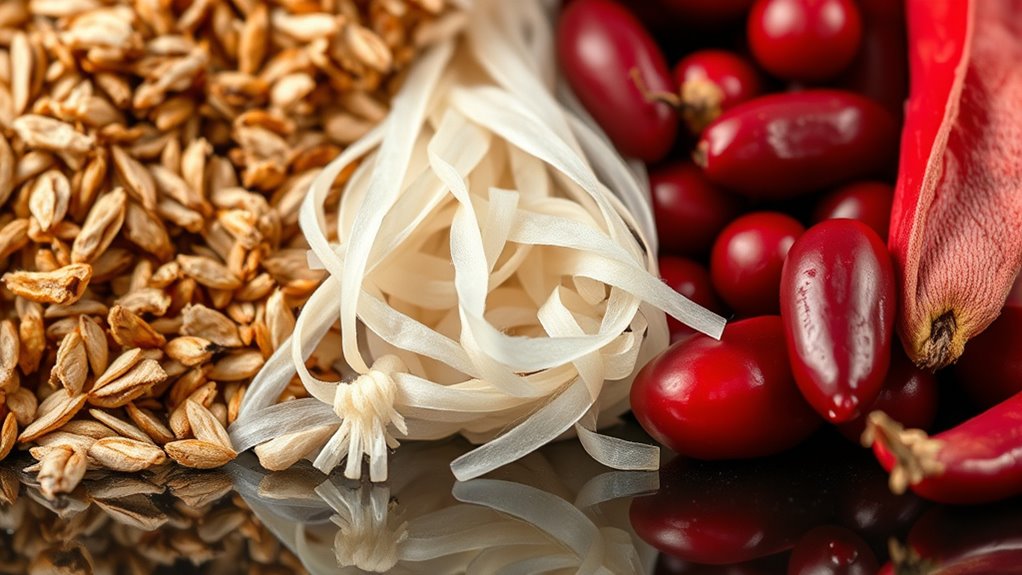You should know that fiber comes in two main types: soluble and insoluble, each offering unique health benefits. Soluble fiber dissolves in water, helping lower your cholesterol and stabilize blood sugar, while insoluble fiber adds bulk to your stool, supporting regular digestion. Both types improve your gut health, prevent constipation, and can aid in managing blood sugar levels. If you want to explore how to balance these fibers and stay safe, keep going for more helpful insights.
Key Takeaways
- Soluble fiber dissolves in water, lowers cholesterol, and helps regulate blood sugar levels.
- Insoluble fiber adds bulk to stool, promotes regular bowel movements, and prevents constipation.
- Sources include oats, beans, fruits, and vegetables for soluble fiber; whole grains, nuts, and vegetable skins for insoluble fiber.
- Both fibers support digestive health, with soluble fiber aiding in cholesterol management and insoluble fiber enhancing gut motility.
- Adequate fiber intake, balanced between types, improves digestion, stabilizes blood sugar, and promotes overall health.
Understanding Soluble and Insoluble Fiber
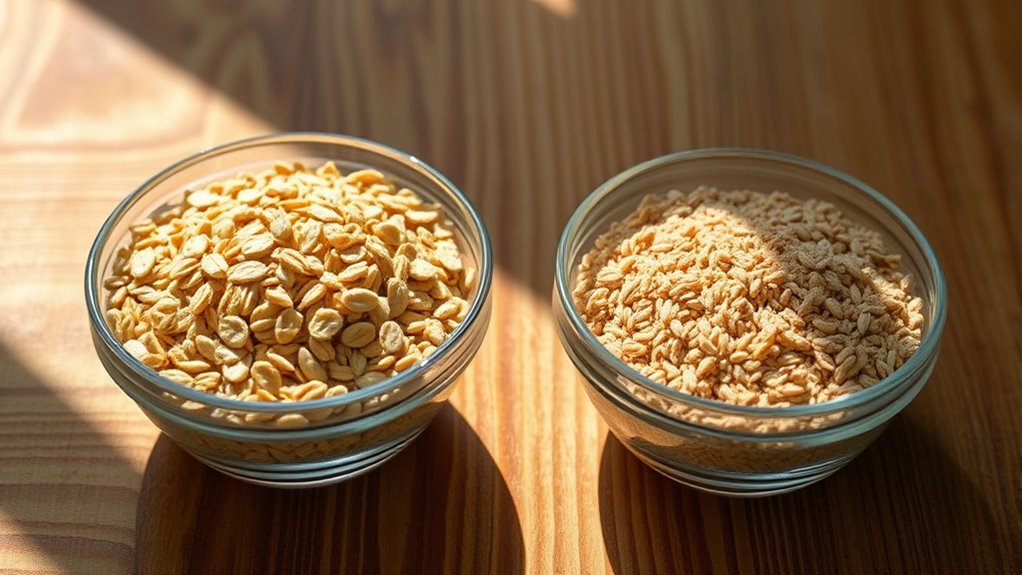
To understand the different types of fiber, it’s important to know that soluble and insoluble fibers play distinct roles in your health. Soluble fiber dissolves in water, forming a gel-like substance in your digestive system. It helps lower cholesterol levels and stabilizes blood sugar, reducing your risk of heart disease and diabetes. You’ll find it in oats, beans, and fruits like apples and oranges. Insoluble fiber, on the other hand, doesn’t dissolve in water. It adds bulk to your stool, promoting regular bowel movements and preventing constipation. You can find it in whole grains, nuts, seeds, and the skins of fruits and vegetables. Both types work together to support your digestive health, but each targets different aspects of your well-being.
Sources of Different Fiber Types
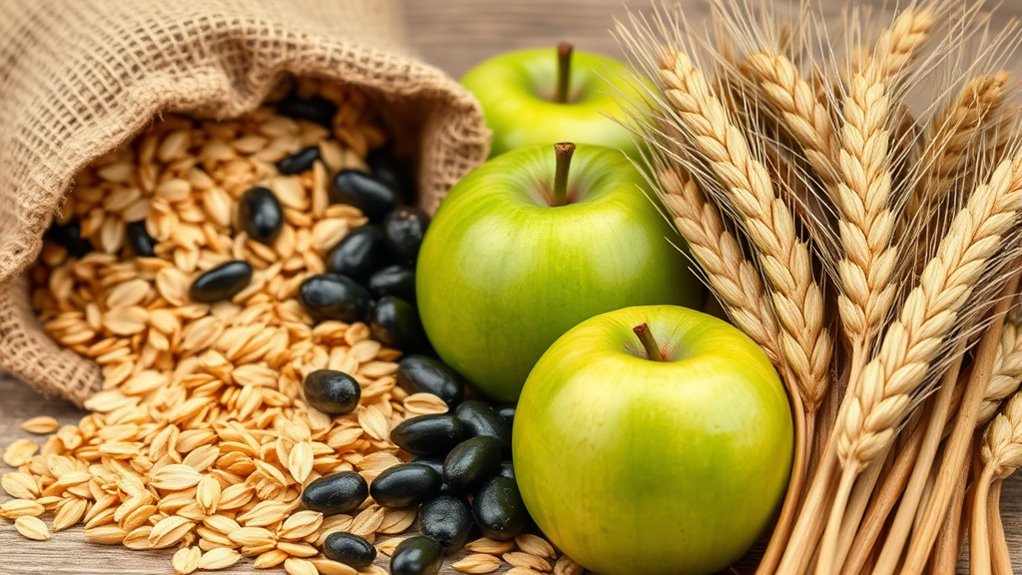
You can find soluble and insoluble fibers in a variety of everyday foods. Soluble fiber is common in foods like oats, beans, and fruits such as apples and oranges. Insoluble fiber is abundant in whole grains, nuts, and vegetables like carrots and broccoli. To visualize these sources:
- Oats, barley, and legumes for soluble fiber
- Whole wheat bread, brown rice, and popcorn for insoluble fiber
- Fruits like berries and citrus, plus vegetables like carrots and leafy greens
Both fiber types are essential for your diet, but they come from different sources. Incorporate a mix of these foods daily to ensure you get the benefits of both soluble and insoluble fibers. This variety helps support digestion, weight management, and overall health.
How Soluble Fiber Benefits Heart Health

Soluble fiber can help lower your cholesterol levels, reducing the risk of heart disease. It also helps regulate blood sugar, keeping your heart healthier overall. By including more soluble fiber in your diet, you support better heart function and long-term health. Incorporating fiber-rich foods can further enhance these benefits and contribute to overall well-being.
Cholesterol Reduction Benefits
Have you ever wondered how certain fibers can help lower your cholesterol levels? Soluble fiber plays a key role by binding to cholesterol in your digestive system, preventing it from entering your bloodstream. This process helps reduce your overall LDL (“bad”) cholesterol, lowering your risk of heart disease. When you consume soluble fiber-rich foods, like oats, beans, or apples, it forms a gel-like substance in your gut that traps cholesterol and bile acids. This encourages your body to use cholesterol to produce more bile, further decreasing blood cholesterol levels. Imagine:
- A thick, sticky substance coating your intestines, capturing cholesterol molecules
- Your body pulling cholesterol from your blood to produce more bile
- Lowered LDL levels leading to healthier arteries and heart health
Blood Sugar Regulation
Building on how soluble fiber helps lower cholesterol, it also plays a significant role in regulating blood sugar levels. When you consume soluble fiber, it forms a gel-like substance in your digestive system, slowing down carbohydrate absorption. This process helps prevent spikes in blood sugar after meals, making it easier to manage diabetes or insulin sensitivity. Incorporating soluble fiber-rich foods like oats, beans, and fruits can improve your blood sugar control and overall heart health. Here’s a quick comparison:
| Benefit | How It Works |
|---|---|
| Slows sugar absorption | Creates a gel that delays carbohydrate breakdown |
| Stabilizes blood sugar | Prevents rapid spikes and crashes |
| Enhances insulin sensitivity | Supports better glucose regulation |
| Reduces risk of complications | Lowers risk of heart disease linked to blood sugar |
| Promotes gut health | Supports beneficial gut bacteria and digestion |
The Role of Insoluble Fiber in Digestion
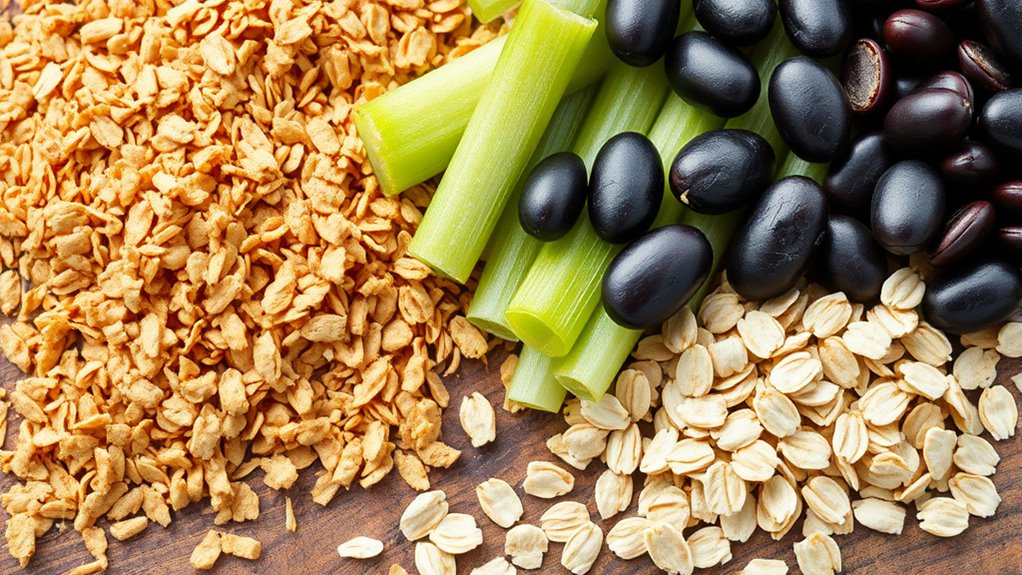
Insoluble fiber helps keep your digestion on track by promoting regular bowel movements. It adds bulk to your stool, making it easier to pass. Including more insoluble fiber in your diet can support a healthy, efficient digestive system. Incorporating high-fiber foods can further enhance its benefits.
Promotes Bowel Regularity
Since insoluble fiber adds bulk to your stool, it plays a crucial role in maintaining regular bowel movements. By increasing stool size, it stimulates your intestines to contract and move waste efficiently. This helps prevent constipation and promotes a healthy digestive rhythm. As you consume more insoluble fiber, you may notice:
- Faster transit time through your gut
- Reduced risk of bloating and discomfort
- Easier, more consistent elimination
These effects keep your bowel movements regular and prevent issues like straining or irregularity. Insoluble fiber works by encouraging the natural movement of waste, helping your digestive system stay active and functioning smoothly. Incorporating fiber-rich foods ensures your bowel stays healthy and regular, supporting overall digestive well-being.
Adds Bulk to Stool
Adding bulk to your stool is one of the key ways insoluble fiber supports digestion. When you consume foods high in insoluble fiber, like whole grains and vegetables, it adds mass to your digestive waste. This increased bulk helps stretch your intestinal walls, signaling your body to move waste along more efficiently. As a result, your stool becomes softer and easier to pass. This process not only prevents constipation but also promotes regular bowel movements. Insoluble fiber isn’t digested in your gut, so it remains intact and continues to do its work. By adding bulk, insoluble fiber helps maintain healthy digestion and reduces the risk of issues like straining or hemorrhoids. Incorporate more insoluble fiber into your diet for a smoother, more efficient digestive process.
Fiber and Blood Sugar Regulation
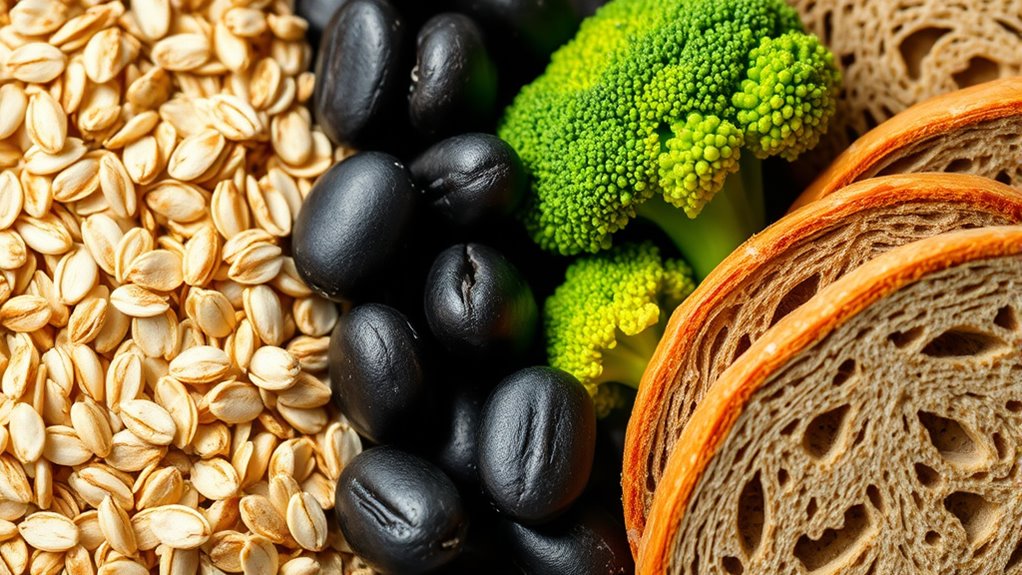
Fiber plays a essential role in regulating blood sugar levels by slowing down how quickly glucose is absorbed into your bloodstream. When you include fiber-rich foods in your meals, they create a barrier that delays digestion, preventing sudden spikes in blood sugar. This helps maintain steady energy and reduces the risk of insulin resistance. Soluble fiber, in particular, forms a gel-like substance that traps sugar molecules, easing their passage into your blood. Incorporating the right type of fiber and practicing mindful eating can enhance these effects and improve your overall health.
Imagine your meal as:
- A slow-release energy source, avoiding rapid sugar surges
- A buffer that helps keep your blood sugar stable
- A tool for better long-term blood sugar management
Incorporating fiber regularly can make a significant difference in your blood sugar control and overall health.
Incorporating Fiber Into Your Diet
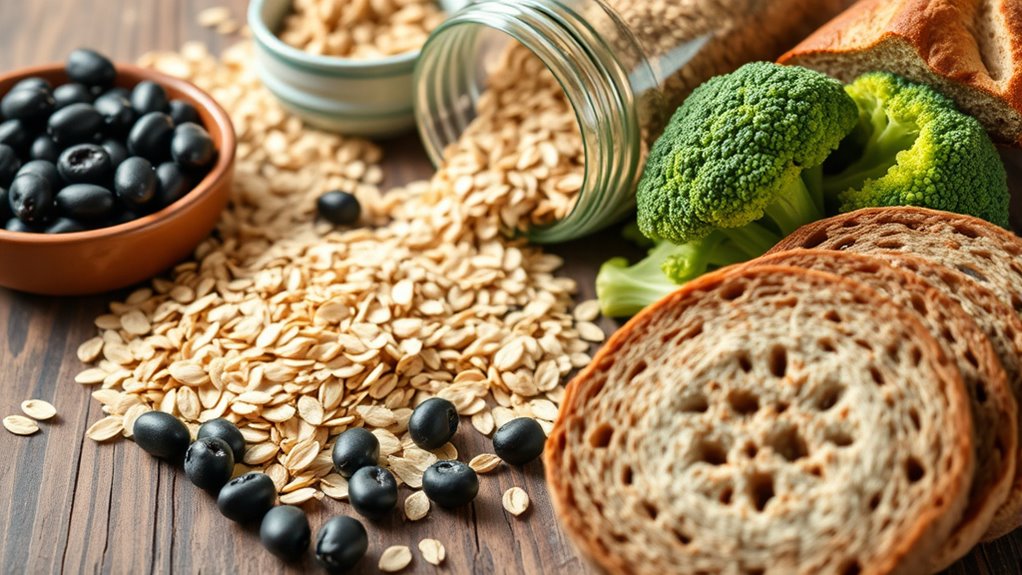
Incorporating fiber into your diet is a practical step toward maintaining steady blood sugar levels and improving overall health. Start by adding more fruits and vegetables to your meals, aiming for a colorful variety. Whole grains like oats, brown rice, and whole wheat bread are excellent fiber sources—swap out refined grains whenever possible. Legumes such as beans, lentils, and chickpeas are rich in fiber and versatile for many dishes. Snack on nuts and seeds in moderation, which also boost your fiber intake. Read food labels carefully to choose high-fiber options, ideally containing at least 3 grams per serving. Incorporating fiber gradually helps your digestive system adjust, preventing discomfort. Cultural breakfast traditions often include fiber-rich foods like whole grains and legumes, supporting your health goals. Consistency is key—small, sustained changes lead to lasting health benefits.
Potential Risks of Excessive Fiber Intake

While increasing your fiber intake offers many health benefits, consuming too much can lead to negative effects. Excessive fiber can cause bloating, gas, and abdominal discomfort as your digestive system struggles to process it. You might also experience nutrient absorption issues, as fiber can interfere with minerals like calcium, iron, and zinc. Additionally, high fiber intake can lead to dehydration if you don’t drink enough fluids. In cases of a Microsoft outage, disruptions may extend to health-related services or digital health records, emphasizing the importance of reliable technology infrastructure. Be cautious if you notice: – Constipation or diarrhea – Feeling overly full or bloated – Nutrient deficiencies over time To avoid these risks, introduce fiber gradually, stay well-hydrated, and listen to your body’s signals. Moderation is key to enjoying fiber’s benefits without adverse effects.
Frequently Asked Questions
How Does Fiber Impact Gut Microbiota Diversity?
When you consume fiber, it positively impacts your gut microbiota diversity. Fiber acts as food for beneficial bacteria, encouraging a wide variety of microbes to thrive. This increased diversity enhances your gut health, boosts your immune system, and improves digestion. By eating a fiber-rich diet, you support a balanced microbiome, which plays a vital role in overall well-being and can help prevent various health issues.
Can Fiber Intake Influence Mental Health or Mood?
Imagine your mind as a garden, where nutrients shape its bloom. Your fiber intake can influence mental health and mood by fueling your gut microbiota, which produces mood-related neurotransmitters like serotonin. When you eat enough fiber, you support a healthy gut environment, potentially reducing anxiety and depression. So, by choosing fiber-rich foods, you’re nurturing your mental well-being as surely as tending to a flourishing garden.
Are There Differences in Fiber Needs for Vegetarians Versus Non-Vegetarians?
You might wonder if your diet influences how much fiber you should eat. As a vegetarian, you likely consume more plant-based foods, so your fiber needs could be higher to support digestive health and overall well-being. Non-vegetarians may get fiber from varied sources, but it’s crucial to meet daily recommended amounts. Adjust your intake based on your diet to guarantee ideal health benefits and proper digestion.
How Does Fiber Consumption Affect Nutrient Absorption?
Fiber acts like a traffic controller in your gut, influencing how nutrients move and get absorbed. When you eat enough fiber, it slows down digestion, giving your body more time to absorb essential nutrients. On the flip side, too much fiber can hinder absorption by binding to minerals like calcium and iron. So, balancing your fiber intake ensures your digestive system runs smoothly and nutrients are fully utilized.
What Are the Best Ways to Measure Daily Fiber Intake?
To measure your daily fiber intake, start by keeping a food diary, noting every meal and snack. Utilize nutrition labels to check fiber content, and consider using mobile apps designed for tracking nutrients. Aim for around 25-30 grams daily, based on your age and gender. Regularly reviewing your records helps you stay on track, identify gaps, and make healthier choices to meet your fiber goals.
Conclusion
So, next time you’re chugging that fiber-rich smoothie, remember: you’re basically building a tiny army of superheroes inside your gut. Soluble fibers are your heart’s best friends, while insoluble fibers keep things moving like a well-oiled machine. Just don’t go overboard—too much fiber might turn your digestive system into a chaotic circus. Embrace the fiber feast wisely, and you’ll have a healthier, happier body cheering you on from the inside out!
